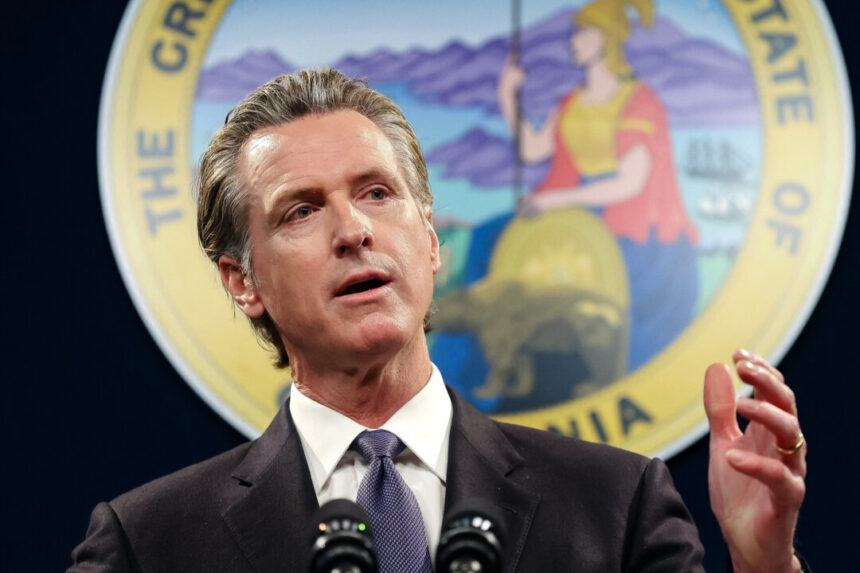Commentary
Even as California is falling apart on his watch, Gov. Gavin Newsom is meddling in other states’ abortion policies. On April 24, his office
declared, “Governor Newsom & Women’s Caucus Announce Bill to Allow Arizona Doctors the Ability to Provide Abortion Care to Arizona Patients in California.”
Senate Bill 233 was previously an electric vehicle bill that was changed under the deceptive “gut and amend” process. It allows legislators effectively to introduce new bills after the supposed Feb. 16
deadline by entirely “gutting” the old language and plopping in new language.
The abortion action was a reaction to Arizona’s 1864 ban on abortion going back into effect after being reinstated by the state’s Supreme Court.
Yet, even as Mr. Newsom was grandstanding, the Arizona House of Representatives
voted to repeal the 1864 ban. If it passes the Senate, Gov. Katie Hobbs said she would sign it. Presumptive Republican presidential nominee Donald Trump has backed the repeal. If it is repealed, the state will still have some restrictions on abortion. Unlike in California, where
Proposition 1 from 2022 placed a complete legalization in the state constitution.
What About the State of California?
Meanwhile, Mr. Newsom still has to give his annual State of the State address. In mid-March, the excuse was he was waiting to find out if this year’s
Proposition 1 passed because the vote was so narrow. It will issue $6.4 billion for homeless programs. Secretary of State Shirley Weber
certified the vote on April 12. Still no State of the State.
In 2023, instead of a State of the State address, on March 22 he delivered a five-page
letter to Assembly Speaker Anthony Rendon (D-Lakewood) and Senate President pro Tempore Toni Atkins (D-San Diego). Mr. Newsom said it fulfilled the requirement in the California Constitution for the governor to “report to the Legislature each calendar year on the condition of the State.”
Perhaps technically.
But whereas his March 8, 2022 State of the State address was watched by many thousands live, and the YouTube
stream garnered 31,000 views, almost no one read the letter. The people of California have not had a televised report on their state in more than two years.
Meanwhile, as I have reported in The Epoch Times, last October he traveled to communist China. I
titled my article, “Gov. Newsom Embarrasses California in Meeting Dictator Xi in China.” The next month he
flew to Atlanta for his quasi-presidential contender debate with Republican Florida Gov. Ron DeSantis.
If Nero fiddled while Rome burned, Mr. Newsom jetted while California decayed.
Unemployment Insurance Debt
The latest problem is described in the Los Angeles Times, where Don Lee is one of the few reporters who understands numbers. “California’s massive budget deficit, coupled with the state’s relatively high level of joblessness, has become a major barrier to reducing the billions of dollars of debt it has incurred to pay unemployment benefits,” he wrote.
“The surge in unemployment brought on by the COVID-19 pandemic pushed the state’s unemployment insurance trust into insolvency. And over the last year California’s joblessness has been on the upswing again, reaching 5.3% in February, the highest among all states. The March job numbers come out Friday.”
“To keep the safety-net program operating at a time when the taxes paid by employers and earmarked for jobless benefits are insufficient, Sacramento has been borrowing billions of dollars from the federal government. The debt now stands at about $21 billion and growing, an increasing burden for state deficit fighters and for the businesses that pay into the jobless insurance program.”
May Revision Coming
The crunch comes before Mr. Newsom submits his May Revision to his Jan. 10 budget proposal. The revision is one thing he can’t avoid. Although perhaps he will forego the typical budget briefing given by a California governor. He actually has been quite good with those in the past, showing a strong grasp of the numbers.
The Jan. 10 proposal calculated a $38 billion budget deficit. But the Legislative Analyst’s Office (LAO), in its latest
calculation from Feb. 20, pegged it at $73 billion. Mr. Newsom’s May “Revise,” to use Sacramento parlance, will provide the starting point for budget negotiations. Shortly after, the LAO will come in with its own final estimates.
On April 11, Democratic leaders in the Legislature said they already had
identified $17 billion in cuts. That leaves $21 million to go according to Mr. Newsom’s estimate, or $56 more according to the LAO’s.
His previous budgets fell into the trap long known about California budgets: depending on soaking rich people with higher taxes. This is even known in China, whose tech companies of course have deep connections with Silicon Valley as well as competing with them.
Look at this Feb. 13
report from China’s state-run Xinhua news agency: “A study has found that taxes play a role in determining where people choose to live, and in California taxes on high earners are driving wealthy people out of the U.S. western state.
“The study, titled ‘Behavioral Responses to State Income Taxation of High Earners: Evidence from California,’ analyzed taxpayers’ response to Proposition 30, a California taxation measure.
According to Joshua Rauh, a fellow at the Hoover Institution of Stanford University, the top 1 percent of California taxpayers bear 50 percent of the state’s income tax burden and are highly influenced by tax policy.
The recent increase in California’s income tax rates, with the top rate now at 14.4 percent and the middle-class rate at 10.4 percent, has raised concerns. This is higher than the top rate on billionaires 20 years ago.
As the LAO examines the state’s finances next month, the impact of these tax hikes on revenues will become clearer.
The Chinese Communist Party may have found amusement in a Xinhua article highlighting the struggles of Silicon Valley competitors due to the drain of investment capital caused by the state’s tax policies.
Comparing tax rates, China’s top income tax rate stands at 45 percent, while in California, the combined top state and federal rate is 51.4 percent, exceeding China’s rate by 6.4 percentage points.
Conclusion: Return of the Rollercoaster
California’s income tax revenues have a history of fluctuating dramatically. They peak during good times and plummet during bad times. Governor Newsom, with his experience in San Francisco and as lieutenant governor, understands this cycle well.
Governor Jerry Brown’s prudent budgeting practices in the past have been commendable, with spending kept below 6.2 percent of California’s personal income, known as “Seiler’s Law.” However, Governor Newsom’s recent budgets have exceeded this threshold, leading to concerns about fiscal stability.
Governor Brown managed to keep budgets under 5 percent, whereas Governor Newsom’s budgets have surpassed 7 percent, as highlighted in a recent article titled “Of Course Overspending Slammed California Into Massive Deficit.”
California’s rollercoaster of income tax revenues reached a $97 billion surplus two years ago but is now on a downward trajectory as high-income earners and middle-class individuals seek refuge in states with more favorable tax environments.
Views expressed in this article are opinions of the author and do not necessarily reflect the views of The Epoch Times.







